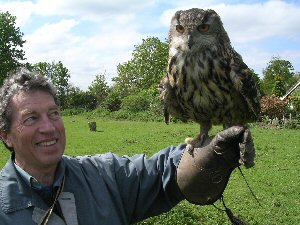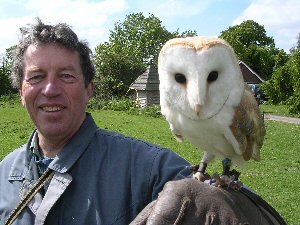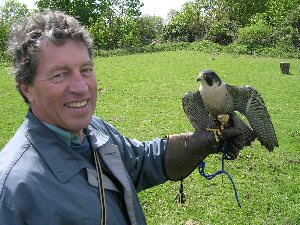Visit to Feathers and Fur
"Look, there's a hawk!" How many people, on seeing a kestrel hanging almost motionless in the air, as if suspended on an invisible wire, or a buzzard circling ever-higher in a thermal, or the lightning-fast dive and superb aerobatics of a peregrine falcon, have volunteered this piece of information? In fact the term "hawk" is of course often inaccurate and is frequently applied by laymen to any day-flying bird of prey which is a member of the Accipitridae, which includes Buzzards, Hawks, Kites, Eagles, Harriers and the Osprey. But it matters not; who can fail to be entranced and amazed by the mastery of the air that these superb birds have evolved to facilitate their various life styles and hunting techniques?
To the majority of us, a distant speck circling or hovering in the sky or a split-second blur of a sparrow hawk or hobby swooping to take its prey are about as close as we get to these magnificent animals, and we have to be content with the superb wildlife pictures that now appear frequently on television or in wildlife magazines. In order to partially overcome this situation I therefore paid a visit to "Feathers and Fur" at Hare Hatch where one can observe, and in most cases handle a varied selection of birds of prey. The birds here are captive-bred but are allowed the freedom of the skies for lengthy periods each day in order to keep fit and hone their flying skills. They can certainly spot and take food from some distance but probably do not have the cutting-edge skills so necessary for survival in the cut-throat wild environment. For this reason they are kept in a secure aviary when not actually flying.
 On arrival I was greeted by Sadie who clearly has encyclopaedic knowledge of birds of prey and the ways and history of falconry. First on my list of avian introductions was a European Eagle Owl, a huge and magnificent bird who greeted me with a loud and apparently reproachful squawk, as if I hadn't paid her the respect she considered she deserved! Having put on specially-designed leather gauntlets we took her into a nearby field where she took off, flew round a couple of times and then settled on a tree stump some 40 yards away. On arrival I was greeted by Sadie who clearly has encyclopaedic knowledge of birds of prey and the ways and history of falconry. First on my list of avian introductions was a European Eagle Owl, a huge and magnificent bird who greeted me with a loud and apparently reproachful squawk, as if I hadn't paid her the respect she considered she deserved! Having put on specially-designed leather gauntlets we took her into a nearby field where she took off, flew round a couple of times and then settled on a tree stump some 40 yards away.
 I was then given a piece of meat to hold and at the given signal she was off - straight as an arrow towards me, landing on my glove and enjoying the food on offer. I was surprised at how light she was for such a huge bird - about 5lbs. Eagle Owls, I was told, hunt primarily by sight which explains why the eyes are so large compared to the heart-shaped facial disc which apparently is an organ of hearing. As the bird approaches it is obvious from its staring and unblinking eyes that it is completely focused on just one thing - its prey. I certainly wouldn't give the unfortunate mouse or vole much chance! I was then given a piece of meat to hold and at the given signal she was off - straight as an arrow towards me, landing on my glove and enjoying the food on offer. I was surprised at how light she was for such a huge bird - about 5lbs. Eagle Owls, I was told, hunt primarily by sight which explains why the eyes are so large compared to the heart-shaped facial disc which apparently is an organ of hearing. As the bird approaches it is obvious from its staring and unblinking eyes that it is completely focused on just one thing - its prey. I certainly wouldn't give the unfortunate mouse or vole much chance!
 Next on the list was a beautiful Barn Owl. In contrast to the previous species they detect prey mainly by sound and hence the eyes are relatively small although still very sharp! As before, she perched on a convenient branch some distance away; I then happened to look away for a few seconds and was then taken by surprise to find her sitting right beside me, completely unaware of her approach! The ability to fly in near-silence is of course a great aid to hunting mice and voles which the Barn Owl has developed to perfection. This is achieved largely through the structure and layout of the feathers but also by the absence of any oils in the feathers. There is a down side to this; it means that they are not waterproof and are therefore vulnerable to bad weather. Apparently the species has been badly hit this winter, especially in Scotland where it is feared it may again become extinct as an inland breeding species after several years of recovery. Next on the list was a beautiful Barn Owl. In contrast to the previous species they detect prey mainly by sound and hence the eyes are relatively small although still very sharp! As before, she perched on a convenient branch some distance away; I then happened to look away for a few seconds and was then taken by surprise to find her sitting right beside me, completely unaware of her approach! The ability to fly in near-silence is of course a great aid to hunting mice and voles which the Barn Owl has developed to perfection. This is achieved largely through the structure and layout of the feathers but also by the absence of any oils in the feathers. There is a down side to this; it means that they are not waterproof and are therefore vulnerable to bad weather. Apparently the species has been badly hit this winter, especially in Scotland where it is feared it may again become extinct as an inland breeding species after several years of recovery.
 Everybody knows and appreciates the kestrel but to actually hold and observe one at close quarters is something else. It immediately becomes apparent what a superb hunting machine it is - aerodynamic design giving complete mastery of the air including the uncanny ability to hover motionless even in a strong wind; large eyes that can spot a small beetle or grasshopper at great distance, and talons that can only be describes as fearsome and that I'm sure would penetrate an unprotected human hand with the greatest of ease. The kestrel, and other birds of prey, has evolved a most ingenious way of saving energy. Having caught their prey, they will grasp it in their talons and nothing will persuade them to let go! This would of course require the use of muscles and hence valuable energy. However, having grasped its prey the talons are held tightly closed by a sort of ratchet system that can only go one way - tighter - so the bird in effect doesn't even have to think about it and the muscle energy is no longer required. Having consumed the meal the kestrel then releases the "ratchet" having used a minimum of energy - very important to a bird of prey where food is sometimes in short supply. Everybody knows and appreciates the kestrel but to actually hold and observe one at close quarters is something else. It immediately becomes apparent what a superb hunting machine it is - aerodynamic design giving complete mastery of the air including the uncanny ability to hover motionless even in a strong wind; large eyes that can spot a small beetle or grasshopper at great distance, and talons that can only be describes as fearsome and that I'm sure would penetrate an unprotected human hand with the greatest of ease. The kestrel, and other birds of prey, has evolved a most ingenious way of saving energy. Having caught their prey, they will grasp it in their talons and nothing will persuade them to let go! This would of course require the use of muscles and hence valuable energy. However, having grasped its prey the talons are held tightly closed by a sort of ratchet system that can only go one way - tighter - so the bird in effect doesn't even have to think about it and the muscle energy is no longer required. Having consumed the meal the kestrel then releases the "ratchet" having used a minimum of energy - very important to a bird of prey where food is sometimes in short supply.
Buzzards are now happily far more often seen around these parts than has been the case for many years and can often be seen sharing a thermal with kites. I was unable to actually handle the Buzzard at "Feathers and Fur" for more than a few seconds as he is wary of contact with other animals due to an unfortunate encounter with a fox with which he luckily escaped with his life. He will let you get very close to him however and to be the object of the glare from his eagle-like face verges on the unnerving.
 The final British bird of prey that I handled was the celebrated Peregrine falcon, now happily far more common than it once was. The example at Feathers and Fur is actually a hybrid and not a pure Peregrine but is very similar in both habits and looks, apart from having a white breast. The peregrine is, by common consent the ultimate master of the air and has long held the first place among the hawks that are trained for the chase. Look at a peregrine's nostrils ("nares") closely and you will see a small triangular projection in the centre. This is reckoned to divert the blast of the wind away from the bird's eyes as it hurtles along - a fact that was, it is said, noted by the designers of Concord and subsequently used to direct the airflow in the engines! The final British bird of prey that I handled was the celebrated Peregrine falcon, now happily far more common than it once was. The example at Feathers and Fur is actually a hybrid and not a pure Peregrine but is very similar in both habits and looks, apart from having a white breast. The peregrine is, by common consent the ultimate master of the air and has long held the first place among the hawks that are trained for the chase. Look at a peregrine's nostrils ("nares") closely and you will see a small triangular projection in the centre. This is reckoned to divert the blast of the wind away from the bird's eyes as it hurtles along - a fact that was, it is said, noted by the designers of Concord and subsequently used to direct the airflow in the engines!  The peregrine I handled immediately flew to the top of a neighbouring oak, causing terror among its resident songbirds as they dashed for cover! By way of exercise and training Sadie then produced a tempting tit-bit on the end of a strong string which she then swung round and round, pulling it out of the way at the very last minute. The dash and agility, almost fury, that the peregrine exhibited as he dived and twisted unharmed at breakneck speed through the branches was simply breathtaking, displaying the greatest imaginable command of wing. Once seen never forgotten! Happily he was eventually allowed to capture and enjoy his meaty morsel! The peregrine I handled immediately flew to the top of a neighbouring oak, causing terror among its resident songbirds as they dashed for cover! By way of exercise and training Sadie then produced a tempting tit-bit on the end of a strong string which she then swung round and round, pulling it out of the way at the very last minute. The dash and agility, almost fury, that the peregrine exhibited as he dived and twisted unharmed at breakneck speed through the branches was simply breathtaking, displaying the greatest imaginable command of wing. Once seen never forgotten! Happily he was eventually allowed to capture and enjoy his meaty morsel!
If you would like to see these birds in close-up, have a go at handling them and have any questions about birds of prey in general answered, you may wish to pay a visit to "Feathers and Fur" which will be found behind Ladd's Garden Centre at Hare Hatch. Sessions last 2 hours and need to be booked up in advance. I'm not sure of the cost as it was actually a birthday present to me, but I can certainly recommend it.
Alan Broodbank
Disclaimer: I have no connection whatsoever with "Feathers and Fur" apart from that of being a satisfied customer.
|